Germany GDP grew 0.1% qoq in Q3, beat expectation of -0.1% qoq. Returning to growth suggests that the Eurozone’s largest economy had avoided a technical recession. Over the year, GDP grew 0.5% yoy, price and calendar adjusted. Economy Minister Peter Altmaier said “we do not have a technical recession, but the growth numbers are still too weak.”
China production, retail sales, investment all missed expectations
The batch of October economic data released from China today is way below expectations. Industrial production growth slowed to 4.7% yoy, below expectation of 5.5% yoy. Fixed asset investment slowed to 5.2% ytd yoy, below expectation of 5.4%. That’s also the worst January-October growth since record began in 1996. Retail sales grew 7.2% yoy, missed expectation of 7.8% yoy, matching the more than 16 year low hit in April.
The chance of a recovery in growth momentum hinges on the results of the trade negotiations with US. Tariff rollbacks would be the key for the “easier” phase one deal. Without removing some of the imposed tariffs, in particular the September ones, the deal would be rather meaningless to the real Chinese economy. Of course, the biggest challenges come in the second phase of negotiations when core and fundamental issues, like subsidies to state-owned enterprises, would be addressed.
The Hong Kong HSI drops sharply today in response to the poor Chinese data. It’s also following the steep selloff this week as unrest in the city escalates abruptly. Current development affirms our view that corrective rebound from 24899.93 has completed with three waves up to 27894.56. Deeper fall should be seen back to retest 24899.93 low next.
RBNZ Bascand: The economy is somewhere near a turning point
RBNZ Deputy Governor Geoff Bascand said in an interview that “we actually think the economy is somewhere near a turning point.” He admitted the economy is “definitely going through a weaker stage” and “near-term risks “are probably more on the downside, but it’s a question of how long they persist,”
However, he added, “we’ve put a lot of stimulus in. We’ve got a bit longer to see how it’s transmitting. There’s time to see how that plays out and make a call in February if needed.”
The central bank surprised the markets by keeping the OCR unchanged at 1.00% yesterday. Governor Adrian Orr described the decision as a “tough one”, and the monetary policy committee had debated whether to “take one more insurance cut.”
Japan GDP grow slowed to just 0.2% annualized in Q3
Japan GDP grew 0.1% qoq in Q3, slowed from Q2’s 0.3% qoq and missed expectation of 0.2% qoq. Annualized rate slowed sharply from 1.8% to just 0.2%, way below expectation of 0.9%. GDP deflator accelerated to 0.6% yoy, up from 0.4% yoy and beat expectation of 0.5% yoy. Private consumption growth slowed to 0.4%, down from 0.6%, despite pre-tax hike purchases. Capital spending, though, accelerated to 0.9%, up from 0.7%.
Economy Minister Yasutoshi Nishimura blamed the weak GDP growth on worsening relations with South Korea. He said that had a “big impact” on exports, while dropped -0.7% from the prior quarter. Also, declines in in-bound tourists from South Korea was a drag, along with some impact form the prolonged trade war between US and China.
Australia unemployment rate rose to 5.3%, AUD/JPY completed corrective rebound
In seasonally adjusted terms, Australia employment contracted by -19k to 12.9m in October, way below expectation of 16.2k growth. That’s also the largest monthly drop in three years since late 2016. Full-time jobs dropped -10.3k while part time jobs dropped -8.7k. Unemployment rate rose 0.1% to 5.3%, above expectation of 5.2%. At the same time, participation rate dropped -0.1% to 66.0.
Looking at some details, unemployment rate increased by 0.3 pts in New South Wales (4.8%), and by 0.1 pts in Victoria (4.8%). The seasonally adjusted unemployment rate decreased by 0.2 pts in Tasmania (5.9%), and by 0.1 pts in Queensland (6.5%), with Western Australia and South Australia recording no change.
The set of data suggests that Australia remains a long way from RBA’s full employment estimation, i.e., unemployment rate at around 4.5%. More monetary and fiscal stimulus is still needed to support the job and wage markets, and drive up inflation. RBA is still on track for more rate cuts or even QE next year.
Today’s sharp fall in AUD/JPY firstly suggests short term topping at 75.67. More importantly, the break of 55 day EMA argues that corrective rise from 69.95 could have completed with three waves up to 75.67, just ahead of 76.16 structural resistance. Further fall is now in favor back to 71.73 support. Break there will reaffirm medium term bearishness for a new low below 69.95 ahead.
Fed Powell: Current monetary policy stance to remain as long as data are consistent with outlook
In the testimony to Joint Economic Committee, Fed Chair Jerome Powell said the baseline outlook is “favorable”. And current monetary policy stance will remain appropriate as long as the outlook is unchanged.
On the economy, Powell said “my colleagues and I see a sustained expansion of economic activity, a strong labor market, and inflation near our symmetric 2 percent objective as most likely”. But “noteworthy risks to this outlook remain”, including sluggish growth abroad and trade developments. Inflation pressures “remain muted” and long-term inflation expectations are at the “lower end of their historical ranges”.
Nevertheless, he added “we see the current stance of monetary policy as likely to remain appropriate as long as incoming information about the economy remains broadly consistent with our outlook”. “if developments emerge that cause a material reassessment of our outlook, we would respond accordingly”. But he emphasized “policy is not on a preset course”.
US CPI picked up t 1.8%, but core slowed to 2.3%
US CPI rose 0.4% mom in October versus expectation of 0.3%. Core CPI rose 0.2% mom, matched expectation. Annually, headline CPI accelerated to 1.8% yoy, up from 1.7% yoy and beat expectation of 1.7% yoy. CPI core, on the other hand, slowed to 2.3% yoy, down from 2.4% yoy and missed expectation of 2.4% yoy.
SNB Jordan emphasized negative rates and readiness to intervene as necessary
SNB Chairman Thomas Jordan reiterated the stance on negative interest rate, and readiness for intervention at the meeting with the seven member Federal Council. the Council said in a statement that “inflation is down, the global low interest environment has grown further entrenched and the situation on foreign exchange markets remains fragile.” “Against this backdrop, Chairman Jordan emphasized that monetary policy with negative interest rates and the readiness to intervene is just as necessary as before.”
Eurozone industrial production rose 0.1% mom, vs expectation of -0.2% mom
Eurozone industrial production rose 0.1% mom in September, above expectation of -0.2% mom. Over the year, Eurozone industrial production dropped -1.7% yoy. Production of non-durable consumer goods rose by 1.0% mom and capital goods by 0.6% mom, while production of durable consumer goods fell by -0.7% mom, energy by -0.8% mom and intermediate goods by -0.9% mom.
EU28 industrial production rose 0.2% mom, dropped -1.2% yoy. Among Member States for which data are available, the highest increases in industrial production were registered in Ireland (+8.8%), Hungary (+3.1%), Denmark, Croatia and Lithuania (all +2.5%). The largest decreases were observed in Malta (-3.7%), Portugal (-2.3%) and Estonia (-1.5%).
UK CPI slowed to 1.5% yoy, missed expectation of 1.6% yoy
UK CPI slowed to 1.5% yoy in October, down from 1.7% yoy, missed expectation of 1.6% yoy. Core CPI was unchanged at 1.7% yoy, matched expectations. RPI slowed to 2.1% yoy, down from 2.4% yoy,missed expectation of 2.6% yoy.
PPI input dropped -5.1% yoy in October versus expectation of -1.8% yoy. PPI output rose 0.8% yoy, missed expectation of 1.3% yoy. PPI output core rose 1.3% yoy, missed expectation of 1.9% yoy.
Australia wage price index rose 0.5% qoq, consumer sentiment rose 4.5%
Australia Wage Price Index rose 0.5% qoq in Q3, matched expectations. The trend and seasonally adjusted indexes for Australia both rose 2.2% through the year. The ABS Chief Economist, Bruce Hockman stated “The rate of annual wage growth eased slightly in September after being stable over the past year, continuing to grow at a slightly faster rate than consumer prices over the past year. The largest contribution to wage growth over the quarter was jobs in the health care and social assistance industry.”
Westpac-MI Consumer Sentiment rose 4.5% to 97.0 in November, up from 92.8. Westpac said “This result continues to support the general view that consumers are somewhat unnerved by the announcement of low rates and media controversy around the banks’ responses.”
Fed Kashkari takes comfort from uninverted yield curve
Minneapolis Fed President Neel Kashkari said yesterday that he takes “comfort” from the US yield curve now. And, “the fact that the yield curve is now uninverted gives me some indication that we have taken the brakes off the economy”.
The US economic outlook is “somewhat mixed”, he added. “But a little bit more optimistic than maybe it was a couple months ago/”
Meanwhile, Kashari said that most US central banks view the current federal funds rate target of 1.50-1.75% as “modestly accommodative”.
Trump warned of substantially higher tariffs if no deal with China
US President Donald Trump commented trade negotiation with China during a speech at the Economic Club of New York yesterday. He said “we’re close — a significant phase one deal could happen, could happen soon.” He added the usual rhetoric that China is “dying” for a deal.
However, he also warned, “if we don’t make a deal, we’re going to substantially raise those tariffs. They’re going to be raised very substantially. And that’s going to be true for other countries that mistreat us too.”
Separately, Larry Kudlow, director of the National Economic Council,said it’s “possible” that tariffs with China could be adjusted as part of the trade deal. But neither side would agree to any tariff adjustments until the deal was finalized. He added, “since there’s no formal agreement we can’t say.”
RBNZ stands pat, long-term inflation expectations remain anchored
New Zealand Dollar rebounds strongly after RBNZ surprised the markets by keeping OCR unchanged at 1.00%. There were some expectation of a cut to 0.75%. But RBNZ opted for a hold and just noted “interest rates will need to remain at low levels for a prolonged period”, and pledged to “add further monetary stimulus if needed.”
The RBNZ Committee noted “recent increases in wage and non-tradables inflation” as ‘expected outcome of monetary stimulus transmitting through the economy.” There was “slight decline in one- and two-year ahead survey measures of inflation expectations”. But “long-term inflation expectations remain anchored at close to the 2 percent target mid-point and market measures of inflation expectations have increased from their recent lows.”
Meanwhile the two options of keeping OCR at 1% versus lowering to 0.75% were debated. “Both actions were broadly consistent with the current OCR projection”. There was a consensus to stand pat. ” The Committee noted that the risks to the economy in the near term were tilted to the downside and agreed it would add further monetary stimulus if economic developments warranted it.”
NZD/USD’s strong rebound suggests that pull back from 0.6465 has completed completed at 0.6322, after breaching 0.6333 support briefly. Rise from 0.6203 might still be in progress. Focus is back 0.6465/6481 resistance zone. Sustained break there will be an early sign of medium term bullish reversal. On the downside, break of 0.6322 will retain medium term bearishness and bring retest of 0.6203 low first.
German ZEW economic sentiment rose to -2.1, growing hope of international improvement
German ZEW Economic Sentiment improved notably to -2.1 in November, up from -22.8, beat expectation of -13.2. German ZEW Current Situation rose to -24.7, up from -25.3, but missed expectation of -22.0. Eurozone ZEW Economic Sentiment also rose sharply to -1.0, up from -23.5, and beat expectation of -11.5. Eurozone Current Situation rose 6.8 to -19.6.
“There is growing hope that the international economic policy environment will improve in the near future, which explains the sharp rise in the ZEW Indicator of Economic Sentiment in November. In the meantime, the chances for a agreement between Great Britain and the EU and thus for a regulated withdrawal of Great Britain have noticeably increased. Punitive tariffs on car imports from the EU to the United States are also less likely than the projections a few weeks ago. An agreement in the trade conflict between the USA and China is appearing more likely too,” comments ZEW President Professor Achim Wambach.
UK employment dropped -58k, largest contraction in four years
UK total employment dropped -58k in the three months to September. That’s the biggest contraction in the job markets in four years, taking employment total down to 32.75m. Unemployment rate dropped to 3.8% in September, down from 3.9%, and beat expectation of 3.9%. Unemployment also dropped -23k ti 1.31m. The set of data suggests that more people have dropped out of the labor market and stopped looking for work.
Wage growth also slowed notably. Average weekly earnings including bonus rose 3.6% 3moy, missed expectation of 3.8% 3moy. Average weekly earnings excluding bonus also slowed to 3.6% 3moy, down from 3.8% 3moy, missed expectations.
RBNZ inflation expectations dropped, solidifying case for another rate cut
In RBNZ’s quarterly Survey of Expectations report, inflation expectation for one year ahead dropped from 1.71% to 1.66%. Expectations for two years ahead also dropped from 1.86% to 1.80%. Mean expectation for the end of quarter OCR dropped from 1.32% to 0.79%. One year expectations also dropped form 1.13 to 0.61%.
The release solidify the case for another RBNZ rate cut to 0.75% tomorrow. The key now is whether RBNZ would give any indication of easing bias, even after the cut. In particular, traders would look for phrase like “there is scope for further fiscal and monetary easing if necessary.”
Australia NAB business confidence and conditions improved, but further stimulus still likely needed
Australia NAB Business Confidence rose from 0 to 2 in October. Business Conditions also rose from 2 to 3. NAB said “this month’s survey results continue to point to only modest outcomes in the business sector, though forward-looking indicators have improved slightly and may be pointing to a stabilisation in conditions.” Also, “acknowledging that the impact of recent rate cuts will take time to flow through the economy, it appears that the support provided by both fiscal and monetary policy this year has done little to offset the slowdown in the business sector.”
Alan Oster, NAB Group Chief Economist, also said: “The business sector has lost significant momentum over the past year or so, putting at risk the optimism around business investment and possibly employment going forward. Overall, we see this as a demand driven issue with private sector demand the weakest since the GFC. It may well be the case that the economy needs further stimulus in addition to the monetary and fiscal support provided so far to support demand and see a lift in business activity and confidence”.




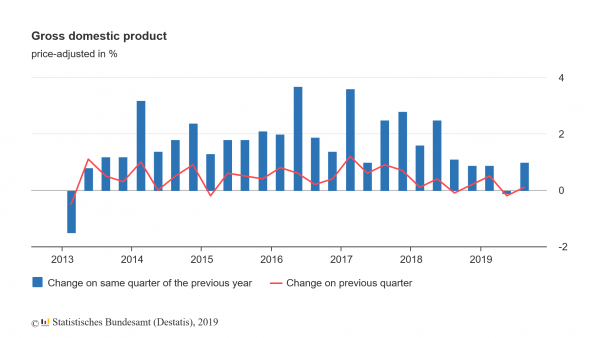
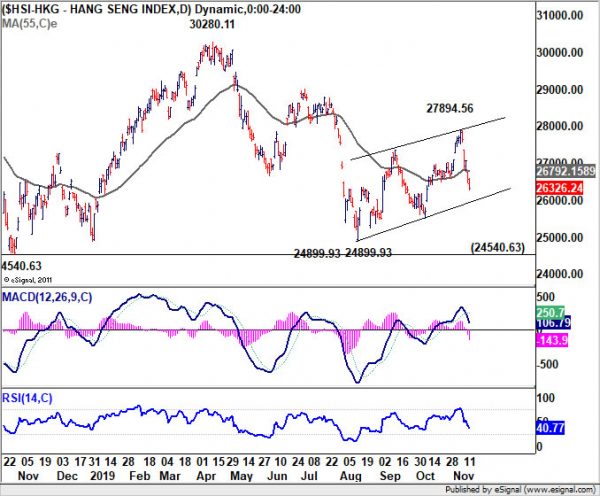
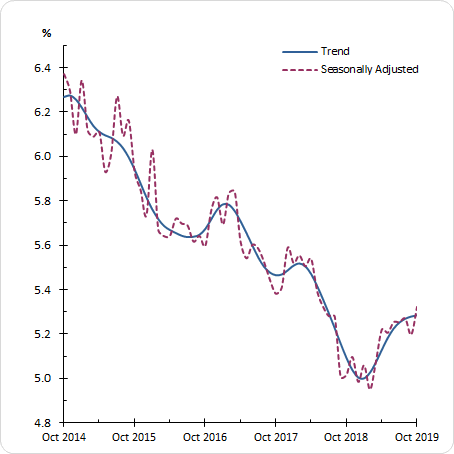
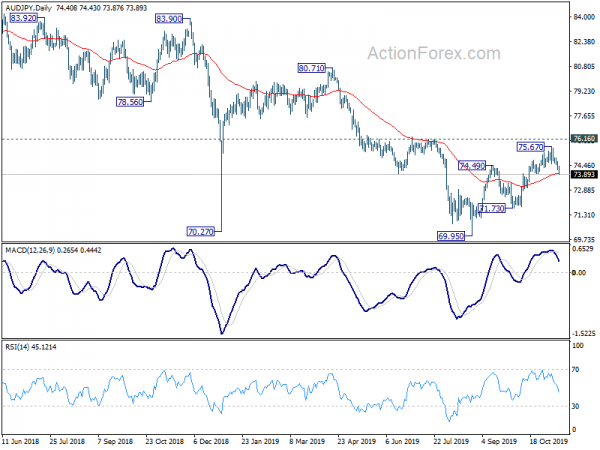

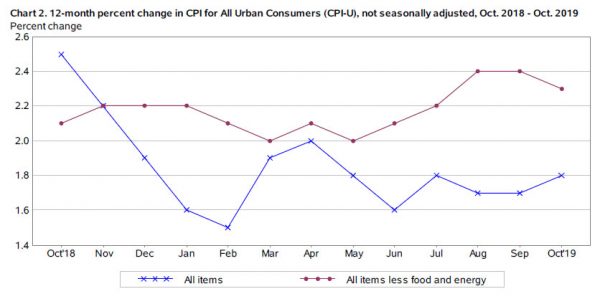
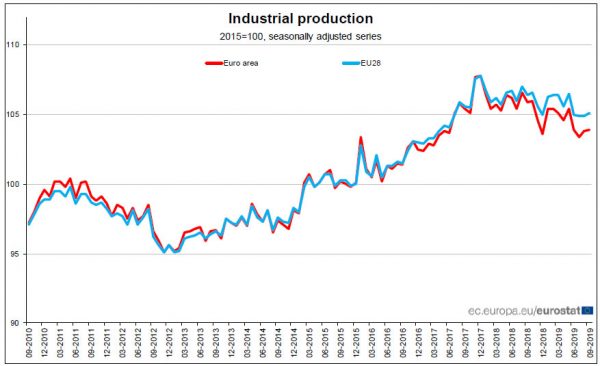
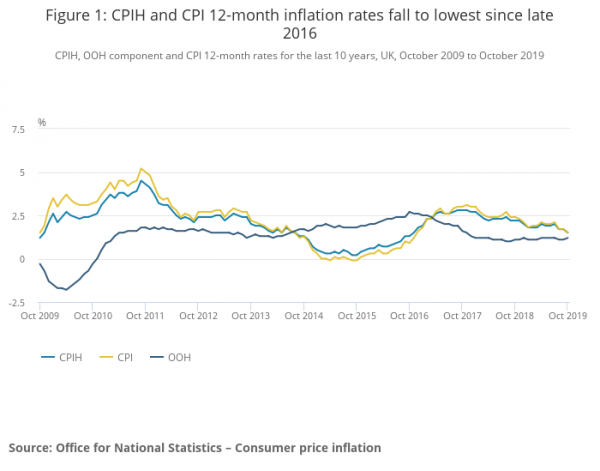
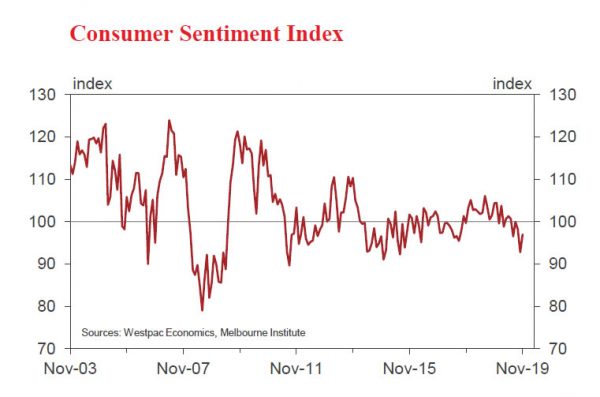
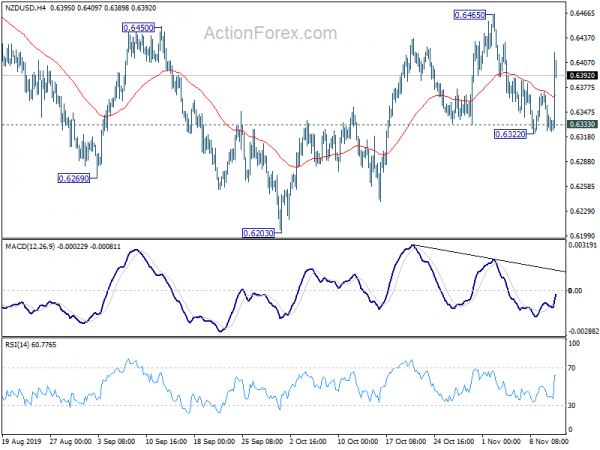
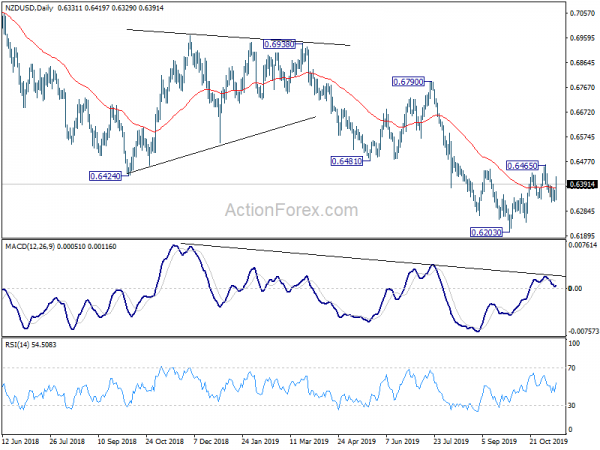
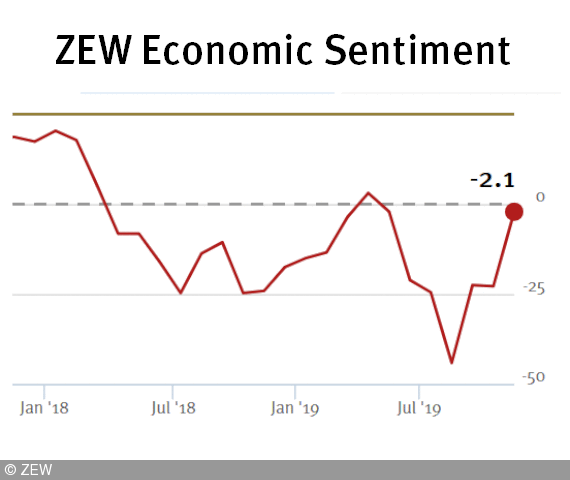
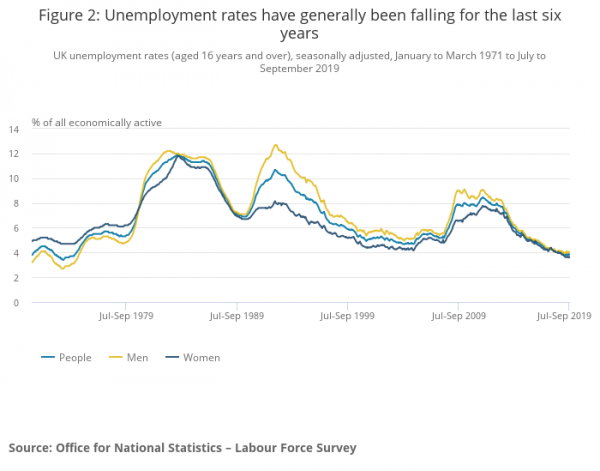
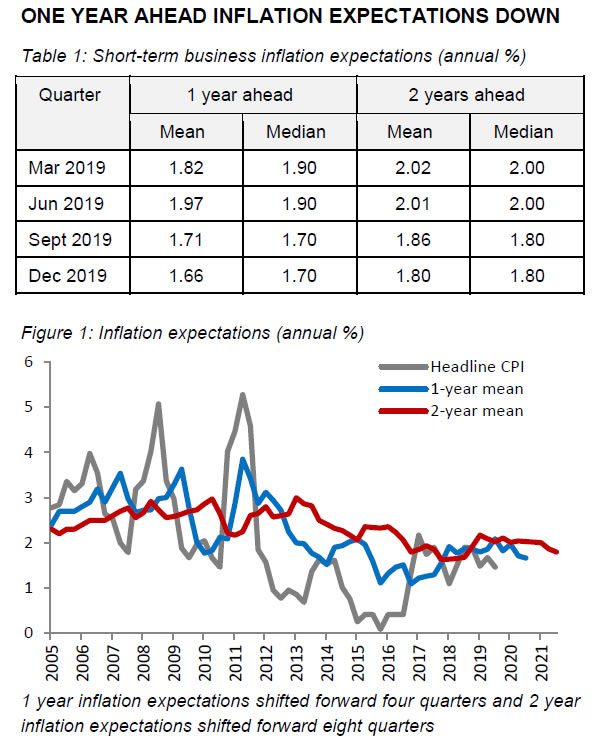
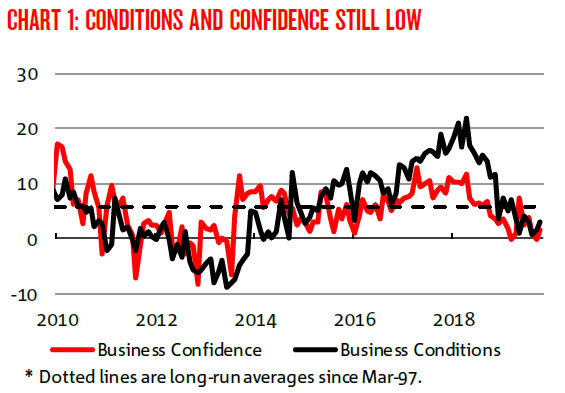

UK retail sales dropped -0.1%, fuel the only positive contributor
UK retail sales dropped -0.1% mom in October while ex-fuel sales dropped -0.3% mom. Over the month, fuel was the only positive contributor to growth in sales, up 0.2% mom. Non-store retailing was flat while non-food and food stores declined.